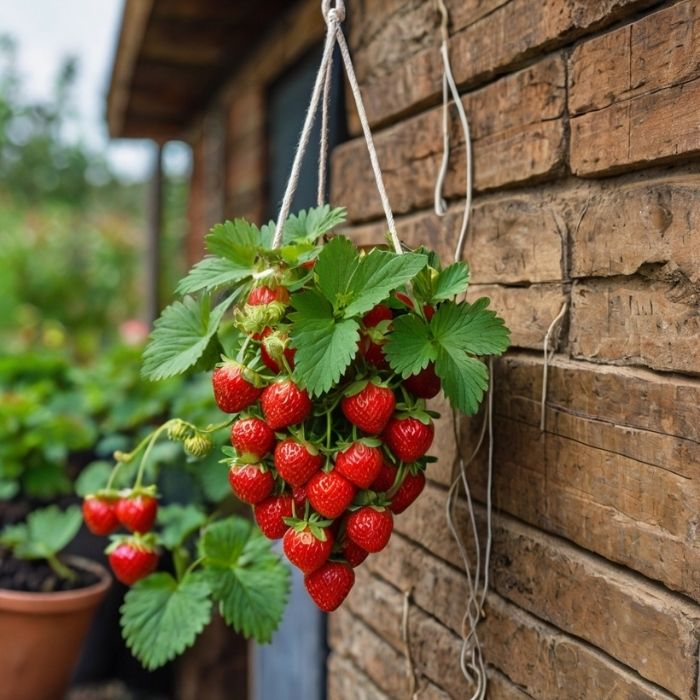Hanging Strawberry Planter: A Complete Guide to Growing Strawberries Vertically
Strawberries are a beloved fruit, known for their sweet flavor and versatility in desserts, smoothies, and snacks. But what if you don’t have a large garden or enough ground space to grow them? Enter the hanging strawberry planter—a brilliant solution for growing strawberries vertically, even in small spaces. Whether you’re a gardening enthusiast or a beginner, this guide will walk you through everything you need to know about hanging strawberry planters, from benefits to step-by-step setup tips.
Why Choose a Hanging Strawberry Planter?
1. Space-Saving Solution
If you’re short on garden space, hanging planters are a game-changer. They allow you to grow strawberries vertically, making them perfect for balconies, patios, or even indoors near a sunny window.
2. Pest Control
Growing strawberries off the ground helps protect them from pests like slugs, snails, and rodents. Hanging planters keep your fruit clean and out of reach.
3. Better Air Circulation
Vertical gardening improves air circulation around the plants, reducing the risk of fungal diseases and promoting healthier growth.
4. Aesthetic Appeal
Hanging strawberry planters add a touch of greenery and charm to your space. Imagine lush green leaves and bright red strawberries cascading down from a planter—it’s both functional and beautiful.
Types of Hanging Strawberry Planters
There are several types of hanging planters to choose from, depending on your needs and preferences:
1. Fabric Hanging Planters
Lightweight and breathable, fabric planters are ideal for strawberries. They provide excellent drainage and prevent root rot.
2. Plastic or Resin Planters
Durable and weather-resistant, these planters are perfect for outdoor use. Look for ones with built-in drainage holes.
3. Tiered Hanging Planters
These multi-level planters allow you to grow multiple strawberry plants in a single unit, maximizing space and yield.
4. DIY Hanging Planters
For the crafty gardener, you can create your own hanging planter using materials like PVC pipes, old buckets, or even recycled bottles.
How to Set Up a Hanging Strawberry Planter
Step 1: Choose the Right Planter
Select a planter that suits your space and style. Ensure it has proper drainage to prevent waterlogging, which can harm strawberry plants.
Step 2: Pick the Perfect Location
Strawberries need at least 6-8 hours of sunlight daily. Hang your planter in a sunny spot, such as a balcony, patio, or near a south-facing window.
Step 3: Use the Right Soil
Strawberries thrive in well-draining, slightly acidic soil (pH 5.5-6.5). Use a high-quality potting mix enriched with organic compost for optimal growth.
Step 4: Plant Your Strawberries
- Fill the planter with soil, leaving about 2 inches from the top.
- Gently remove the strawberry plant from its nursery pot and place it in the planter.
- Space the plants about 8-12 inches apart to allow room for growth.
- Cover the roots with soil and press lightly to secure the plant.
Step 5: Water Regularly
Strawberries need consistent moisture, especially during the growing season. Water the plants when the top inch of soil feels dry, but avoid overwatering.
Step 6: Fertilize for Optimal Growth
Feed your strawberry plants with a balanced fertilizer every 2-3 weeks during the growing season. Avoid over-fertilizing, as this can lead to excessive foliage growth at the expense of fruit production.
Tips for Maintaining Your Hanging Strawberry Planter
1. Prune Regularly
Remove dead leaves and runners to encourage healthy growth and fruit production. Pruning also improves air circulation, reducing the risk of disease.
2. Protect from Extreme Weather
If you live in an area with harsh weather conditions, consider moving your planter indoors or to a sheltered spot during storms or extreme heat.
3. Rotate the Planter
To ensure even sunlight exposure, rotate your planter every few days. This helps all sides of the plant receive adequate light.
4. Watch for Pests
While hanging planters reduce the risk of ground pests, keep an eye out for aphids, spider mites, or birds. Use organic pest control methods if needed.
Best Strawberry Varieties for Hanging Planters
Not all strawberry varieties are suited for hanging planters. Here are some of the best options:
1. Everbearing Strawberries
These varieties produce fruit throughout the growing season, making them ideal for continuous harvests. Examples include Ozark Beauty and Quinault.
2. Day-Neutral Strawberries
Day-neutral varieties, like Seascape and Albion, produce fruit regardless of day length, offering a steady supply of strawberries.
3. Alpine Strawberries
Known for their intense flavor, alpine strawberries are compact and perfect for small hanging planters.
Common Mistakes to Avoid
1. Overcrowding the Planter
Planting too many strawberries in one planter can lead to competition for nutrients and poor growth. Stick to the recommended spacing.
2. Neglecting Drainage
Poor drainage can cause root rot and kill your plants. Always ensure your planter has adequate drainage holes.
3. Inconsistent Watering
Strawberries need consistent moisture. Avoid letting the soil dry out completely or become waterlogged.
4. Ignoring Fertilization
Without proper nutrients, your plants may produce fewer fruits. Stick to a regular fertilization schedule.
Creative Ideas for Hanging Strawberry Planters
1. Vertical Garden Wall
Create a stunning vertical garden by hanging multiple strawberry planters on a wall or trellis.
2. Hanging Basket Display
Use decorative baskets to grow strawberries, adding a rustic charm to your space.
3. Tiered Planter Stand
A tiered stand with multiple levels of hanging planters can maximize your strawberry yield while saving space.
4. Indoor Hanging Planter
Grow strawberries indoors by hanging planters near a sunny window. This is perfect for year-round harvesting.
FAQs About Hanging Strawberry Planters
1. How many strawberry plants can I grow in one planter?
It depends on the size of the planter. Generally, one plant per 8-12 inches of space is recommended.
2. Can I grow strawberries indoors?
Yes, as long as they receive adequate sunlight (6-8 hours daily) and are planted in well-draining soil.
3. How often should I water my hanging strawberry planter?
Water when the top inch of soil feels dry. This is usually 2-3 times a week, depending on the climate.
4. Do hanging strawberry planters need special care?
They require the same care as ground-planted strawberries, with extra attention to watering and sunlight exposure.
Final Thoughts
A hanging strawberry planter is a fantastic way to grow fresh, delicious strawberries, even if you’re limited on space. With the right planter, soil, and care, you can enjoy a bountiful harvest of sweet, juicy strawberries right at your fingertips. Whether you’re a seasoned gardener or just starting out, this vertical gardening method is both rewarding and fun.
So, why wait? Grab a hanging planter, plant your strawberries, and get ready to enjoy the fruits of your labor—literally!

